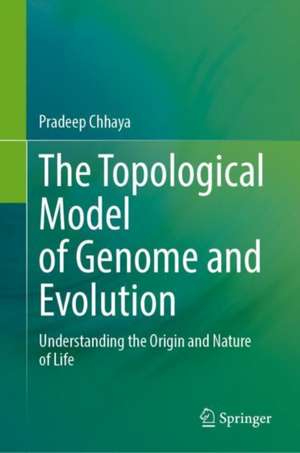The Topological Model of Genome and Evolution: Understanding the Origin and Nature of Life
Autor Pradeep Chhayaen Limba Engleză Hardback – 20 sep 2023
Preț: 1127.15 lei
Preț vechi: 1374.58 lei
-18% Nou
Puncte Express: 1691
Preț estimativ în valută:
215.68€ • 235.01$ • 181.74£
215.68€ • 235.01$ • 181.74£
Carte tipărită la comandă
Livrare economică 24 aprilie-08 mai
Preluare comenzi: 021 569.72.76
Specificații
ISBN-13: 9789819943173
ISBN-10: 9819943175
Ilustrații: XXIII, 546 p. 1 illus.
Dimensiuni: 155 x 235 mm
Greutate: 0.97 kg
Ediția:1st ed. 2023
Editura: Springer Nature Singapore
Colecția Springer
Locul publicării:Singapore, Singapore
ISBN-10: 9819943175
Ilustrații: XXIII, 546 p. 1 illus.
Dimensiuni: 155 x 235 mm
Greutate: 0.97 kg
Ediția:1st ed. 2023
Editura: Springer Nature Singapore
Colecția Springer
Locul publicării:Singapore, Singapore
Cuprins
Chapter 1_Nature of Life: Structuralism and functionalities.- Chapter 2_Nature of Relationship Between: A Genotype and A Phenotype.- Chapter 3_Nature of Genomic Architecture: A Topological Model of Genome.- Chapter 4_Biological Algorithm of Involution: Ontology of Gene Expressions.- Chapter 5_Nature of Developmental Processes in Mammals.- Chapter 6_Nature of Aging Process: Genomic Ontology of Aging.- Chapter 7_Nature of Genomic Evolution: Its imprint in Cancer.- Chapter 8_Nature of Regulatory Genome: The Evolution and Natural Selection of Genotope.- Chapter 9_Principles of Genomic Evolution.
Notă biografică
Dr. Pradeep Chhaya has acted as a technical advisor to the pharmaceutical industry for thirty years. He has postdoctoral research experience. Prior to starting a consultancy, he was a chief executive and a partner of an information content company specialized in value addition to research published globally. He has spent the last fifteen writing research monographs on the foundation of science. At present, seven of his monographs are under various stages of publication. His domains of expertise include spacetime theories, quantum mechanics, mathematics, computations theory, cognitive architecture, molecular biology, medicinal chemistry and linguistics.
.
.
.
.
.
.
.
.
.
.
.
.
.
.
.
.
.
.
.
.
.
.
.
.
.
.
.
.
Textul de pe ultima copertă
This book deals with the missing link in the domain of functional genomics viz. genomic architecture. It begins with a deconstruction of the Darwinian paradigm using the proposed model of modified involuted manifolds. It recasts the process of natural selection as a process of information transfer. Using a topological model, this book outlines a new genomic architecture. The key argument for this proposed model is that some such structuralism has always been implicit in genomics. The proposed model fits very well with the known genomic characteristics and allows to separate the regulatory genome from the transcriptive genomes. The model is capable of discerning modular architecture of genomes with different genomic functionalities existing in hierarchical relationships and demonstrates that genomes act as units of selection and as the environment for the individual genes which act as competing species. Towards the end, the book also examines the role of genomic evolution in cancer and the principles of natural selection and evolution of the genotype. The regulatory genome is also discussed, with an emphasis on its evolution and natural selection. It is a valuable source for researchers working in functional genomics, mathematical modeling in biology and evolutionary genomics.
Caracteristici
Deconstructs Darwinian paradigm using modified involuted manifolds Explores genomic evolution in cancer and principles of natural selection and evolution of genotope Introduces topological model of genome architecture to understand genomic functionalities
